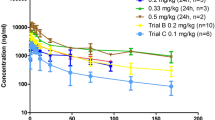Abstract
The photosensitiser 132-hydroxy bacteriopheophorbide a-methylester (132-OH-BPME) is characterised by a high absorption coefficient at the far red wavelength 750 nm and a good singlet oxygen quantum yield. The pharmacokinetics of 132-OH-BPME was studied on the Lewis lung carcinoma in mice after i.v. administration of 5 mg/kg body weight at different incubation intervals. The accumulation dye was chemically extracted from selected tissues and the concentrations were measured by absorption spectroscopy. The parenchymatous organs, liver, spleen and kidney, showed maximum 132-OH-BPME concentrations after 2 h incubation (liver, spleen) and 4 h postinjection (kidney). A high uptake was detected in the lung with the maximum concentration at 2 h. The malignant tissue accumulated high 132-OH-BPME concentrations at 2–12 h postinjection with peaking at 8 h. The 132-OH-BPME concentrations in muscle tissue, representing the normal tumour surroundings, and in the skin were very low. The results of our study suggest that photodynamic therapy (PDT) using 132-OH-BPME could be effective at an incubation time of about 8 h postsensitiser injection, when the tumour 132-OH-BPME concentration has reached its maximum and the muscle and skin concentrations are at a minimum.
Similar content being viewed by others
REFERENCES
Bown S, Tralau C, Coleridge S et al. Photodynamic therapy with porphyrin and phthalocyanine sensitisation: quantitative studies in normal rat liver. Br J Cancer 1986; 54:43–52
Chan W, Marshall J, Svenson J et al. Effect of sulfonation on the cell and tissue distribution of the photosensitizer aluminium phthalocyanine. Cancer Res 1990; 50:4533–8
Moser J, Herchenbach B, Evenschor K et al. Biotechnology of bacteriopheophorbides,'naturally occurring second generation photosensitizers. Laser in Med Sci 1992; 7:272
Röder B, Dressler C, Hagemann R et al. On the pharmacokinetics of 132-hydroxybacteriopheophorbide a methylester studied by fluorescence spectroscopy on Lewis lung carcinoma bearing mice. SPIE 1994; 2078:427–37
Iwai K, Kimura S. Efficiency of pheophorbide dimer in photodynamic therapy of mouse tumour. J Clin Biochem Nutr 1988; 5:145–9
Richter A. Characterization of benzoporphyrine derivatives, a new photosensitizer. SPIE 1988; 997:132–8
Yano T, Uozumi T, Kawamoto K et al. Photodynamic therapy for rat pituitary tumour in vitro and in vivo using pheophorbide a and white light. Laser Surg Med 1991; 11:174–82
Reddi E, Castro G, Biolo R et al. Pharmacokinetic studies with zinc 11 phthalocyanine in tumour-bearing mice. Br J Cancer 1987; 56:597–600
Author information
Authors and Affiliations
Rights and permissions
About this article
Cite this article
Ismail, M.S., Dressler, C., Roder, B. et al. 132-hydroxy-bacteriopheophorbidea-methylester pharmacokinetics in mice bearing Lewis lung carcinoma. Laser Med Sci 13, 78–81 (1998). https://doi.org/10.1007/BF00592963
Issue Date:
DOI: https://doi.org/10.1007/BF00592963



